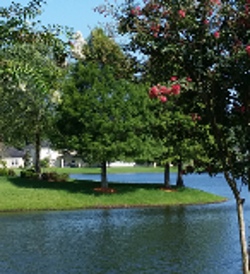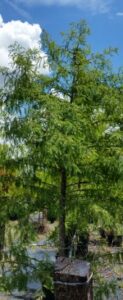S & J Nursery’s Guide to Growing
Bald Cypress Trees
in The Northeast Florida Landscape
( Taxodium distichum )
 Bald Cypress Origins:
Bald Cypress Origins:
– Native
Bald Cypress Preferred Exposure:
– Bald Cypress trees will require a full sun exposure when planted in the North Florida | Jacksonville | St. Augustine area gardens landscape.
Bald Cypress Foliage | Bark:
– Deciduous foliage of the Bald Cypress is a deep green color and very fine textured almost fernlike.
– Bald Cypress bark is a deep dark reddish brown with long vertical lines in it.
 Bald Cypress Tree Soil Preference / Salt tolerance:
Bald Cypress Tree Soil Preference / Salt tolerance:
– Taxodium distichum / Bald Cypress trees are quite tolerant of dry soil conditions despite being a wetland native. They make excellent edge of pond trees where trees roots will rise to the surface making “knees” surrounding the trunk.
– Bald Cypress trees are moderately salt tolerant.
Bald Cypress Size Variance:
– Bald Cypress / Taxodium distichum can reach sizes of 50-60 feet H | 20+ feet Wide.
Bald Cypress Growth Habit:
– Bald Cypress trees will form a narrow Christmas tree like shape.
Bald Cypress Tree Growth Rate:
– bald Cypress / Taxodium distichum has an extremely fast growth rate easily adding a few feet per year to its height.
Bald Cypress Bloom:
– n/a
Bald Cypress Water Requirements:
– Water well after planting for best results and add supplemental irrigation during long periods of drought.
Butterfly or Bird Attracting:
– Migrating Canadian geese and other birds will feed on the seeds of the bald cypress tree.
Best Uses For Bald Cypress Trees in the North Florida | Jacksonville | St. Augustine area Landscape:
– Bald Cypress trees will make an excellent shade tree, garden specimen or street tree in urban areas and parking lots etc.
Care of Bald Cypress Trees:
– Water every day during the establishment period. See watering your newly planted trees for more information.
-They will need good water during the establishment period and supplemental irrigation during dry spells or particularly hot dry summers.
– Prune dead or weakened branches each summer as needed for maximum curb appeal.
– When growing in the gardens landscape provide a 1 ft diameter circle of mulched area where grass is kept from growing for each inch of caliper (or diameter) of trunk measured 4 inches from the ground level.
– Fertilize each spring with a mixture of Milorganite and a slow release poly coated plant food such as Osmocote or Stay Green general purpose plant food, sprinkling the fertilizer around the mulch circle underneath the foliage of the tree

